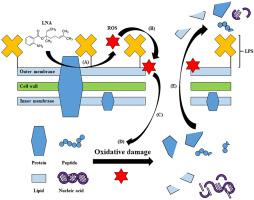Journal of Pharmaceutical Analysis ( IF 6.1 ) Pub Date : 2020-06-06 , DOI: 10.1016/j.jpha.2020.05.014 Shun-Kai Yang , Khatijah Yusoff , Mokrish Ajat , Wai-Sum Yap , Swee-Hua-Erin Lim , Kok-Song Lai

|
Mining of plant-derived antimicrobials is the major focus at current to counter antibiotic resistance. This study was conducted to characterize the antimicrobial activity and mode of action of linalyl anthranilate (LNA) against carbapenemase-producing Klebsiella pneumoniae (KPC-KP). LNA alone exhibited bactericidal activity at 2.5% (V/V), and in combination with meropenem (MPM) at 1.25% (V/V). Comparative proteomic analysis showed a significant reduction in the number of cytoplasmic and membrane proteins, indicating membrane damage in LNA-treated KPC-KP cells. Up-regulation of oxidative stress regulator proteins and down-regulation of oxidative stress-sensitive proteins indicated oxidative stress. Zeta potential measurement and outer membrane permeability assay revealed that LNA increases both bacterial surface charge and membrane permeability. Ethidium bromide influx/efflux assay showed increased uptake of ethidium bromide in LNA-treated cells, inferring membrane damage. Furthermore, intracellular leakage of nucleic acid and proteins was detected upon LNA treatment. Scanning and transmission electron microscopies again revealed the breakage of bacterial membrane and loss of intracellular materials. LNA was found to induce oxidative stress by generating reactive oxygen species (ROS) that initiate lipid peroxidation and damage the bacterial membrane. In conclusion, LNA generates ROS, initiates lipid peroxidation, and damages the bacterial membrane, resulting in intracellular leakage and eventually killing the KPC-KP cells.
中文翻译:

萜烯芳基邻氨基苯甲酸酯对产生碳青霉烯酶的肺炎克雷伯菌的抗菌活性和作用方式
植物来源的抗微生物剂的开采是当前对抗抗生素抗性的主要焦点。进行了这项研究,以表征邻氨基苯甲酸芳樟酯(LNA)对产生碳青霉烯酶的肺炎克雷伯菌(Klebsiella pneumoniae)(KPC-KP)的抗菌活性和作用方式。单独的LNA具有2.5%(V / V)的杀菌活性,与美罗培南(MPM)组合具有1.25%(V / V)的杀菌活性)。比较蛋白质组学分析显示,胞质和膜蛋白的数量显着减少,表明在LNA处理的KPC-KP细胞中膜受损。氧化应激调节蛋白的上调和氧化应激敏感蛋白的下调表示氧化应激。Zeta电位测量和外膜通透性试验表明,LNA会增加细菌表面电荷和膜通透性。溴化乙啶流入/流出试验表明,经LNA处理的细胞对溴化乙锭的吸收增加,从而导致膜损伤。此外,在LNA处理后检测到核酸和蛋白质的细胞内泄漏。扫描和透射电子显微镜检查再次显示细菌膜的破裂和细胞内物质的损失。LNA被发现通过产生活性氧(ROS)诱导氧化应激,该活性氧可引发脂质过氧化作用并破坏细菌膜。总之,LNA产生ROS,引发脂质过氧化,并破坏细菌膜,导致细胞内渗漏并最终杀死KPC-KP细胞。































 京公网安备 11010802027423号
京公网安备 11010802027423号